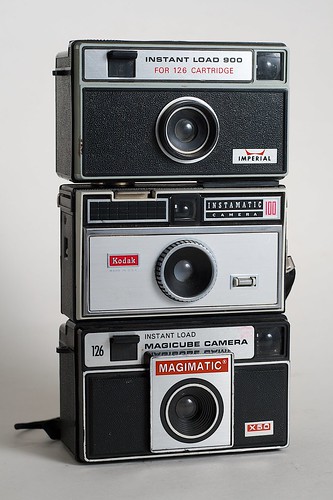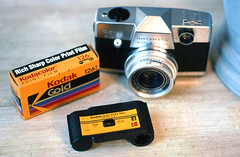126 film
See the Category: 126 film.
Note: 126 film cassettes should not be confused with 126 roll film from the early 20th Century.

|
| Cameras for 126 film cassettes Instant Load 900, Instamatic 100, Magimatic X50 |

|
| Plastic 126 cassette and Instamatic image by Nicholas Middleton (Image rights) |
The 126 film cassette (trademarked by Kodak as "Kodapak") is a plastic film magazine containing film 35mm wide, spooled with a paper backing. This lacks the continuous sprocket holes found in conventional 35mm film; instead there is a single index hole to register the position of each 28×28 mm frame.
As of 2021, these film cartridges have been out of production for many years, with supplies of outdated 126 film very constrained.
The 126 cassette format was launched in 1963 by Kodak in answer to consumer complaints about the complications involved with loading and unloading roll film and 35mm cameras. The use of cassettes eliminates the necessity to attach a film leader to a take-up spool. The cartridge simply drops into the camera. Because the cassette is asymmetric, it cannot be loaded incorrectly. Once the camera back is closed the camera is immediately ready to wind and shoot. For casual users this greatly simplifies the photo taking experience, which was intended to broaden the appeal of 126 cameras and open up new markets for Kodak.
126 cameras have a window to show a portion of the back of the cassette, which is printed with the film details, and has a small hole revealing the frame number printed on the backing paper.
The inventor, Hubert Nerwin, was granted US patent 3,138,081[1] on June 23, 1964. The patent was assigned to Eastman Kodak.
At the end of the roll, it is not necessary to rewind the film. The entire cassette is removed and sent in for processing. Even if the cassette is removed mid-roll, only the current exposure is light-struck; the rest of the film is protected inside the cartridge.
It also incorporated one of the first widely-used mechanical film-speed sensing systems; using notches on the cassette, a speed of 64, 80, 125 or 160 ASA was indicated and set the camera's exposure mechanism. However, not all cameras took advantage of this feature. Kodak patents decades earlier (for example: US patent 2186611 (1938)[2], US patent 2186613 (1937)[3]) described this innovation.
126 film is 35mm wide and has a single perforation per frame. The image size is nominally 26×26mm, though actually it is 28×28mm that is typically masked to approximately 26½×26½mm. Therefore the 26×26mm masked area has just over 80% of the total film frame area of 135 35mm frames, although with modern scanners it is possible to access the entire 28×28mm frame, which is closer to 91% of the film frame area of standard 35mm frames. The film has pre-exposed borders and exposure numbers. Kodak Instamatic 126 cameras were introduced simultaneously with the 126 films, followed by many more Instamatics, and the term "Instamatic" has sometimes been used generically for any camera using the format.
126 film was produced in virtually all standard film bases, including slide film. 126 slides can be mounted in special 2"×2" slide mounts (with 126-appropriate masks) and presented in standard slide projectors.
The 126 format was in some ways a simplification of the ailing 828 roll film format introduced by Kodak in 1935 (along with a range of Kodak Bantam cameras). Both used paper-backed film 35mm wide, with only a single registration hole per frame. However the 828 image format was 28×40 mm, not square. As with all roll films, 828 film requires careful camera loading that takes some time to execute, as opposed to the great simplicity of loading a 126 film cassette.
The decline of the format didn't originate from a lack of cameras in circulation but from the fact that 126 cameras were generally cheap, low end units aimed at a strictly amateur market. Some quality 126 cameras were produced, including SLRs, but they were rare in absolute numbers. One drawback of the cheap plastic cassette format is that the film transport mechanism is contained almost entirely within the cassette, which in the case of 126 film cassettes is generally constructed to low tolerances with significant play in many of the key components. The cassettes themselves also fit relatively loosely into the camera bodies. These loose tolerances make it impossible to maintain precise film positioning, particularly in the film plane. This in turn makes it impossible for higher end cameras to create consistent high-quality images, regardless of the quality of components or designs of the cameras themselves. Also, the 126 cassette could only accommodate a maximum 24-exposure roll. The design of the 126 cassette relegated the format to appeal only to the casual consumer market.
Toward the end of the 1980s and into the 1990s, most consumer-level 35mm cameras provided automatic film loading features, and the 126 cassette's easy loading advantages became obsolete. At the same time, very cheap, pre-loaded, single-use 35mm cameras became available, which were even easier to use than 126 cassette film, with similar or better quality results.
126 cassettes were last produced in 2007 by Ferrania with only old (i.e. freezer-preserved) stocks still for sale today. Some are available under Ferrania's own Solaris label while others are sold rebadged as Adox Adocolor Instamatic by Fotoimpex. These cartridges contain ASA 200 film but there are user reports of them having ASA 64 notches.
It is challenging to adapt 126 cameras to use conventional 35mm film, although there have been a few successful attempts.

|

|
| SLRs for Kodapak film, Contaflex 126 and Instamatic Reflex, images by Casual Camera Collector and Michael Raso (Image rights) | |
Notes
Links
- overview cameras for 126 film (Instamatic central) (archived)
- images of cameras for 126 film at Fotofex
- about 126 film, and another collection (Mischa Koning)
- Adox Adocolor Instamatic (archived)
- 35mm film in 126 cartridge, tutorial by YouTuber Film is more fun